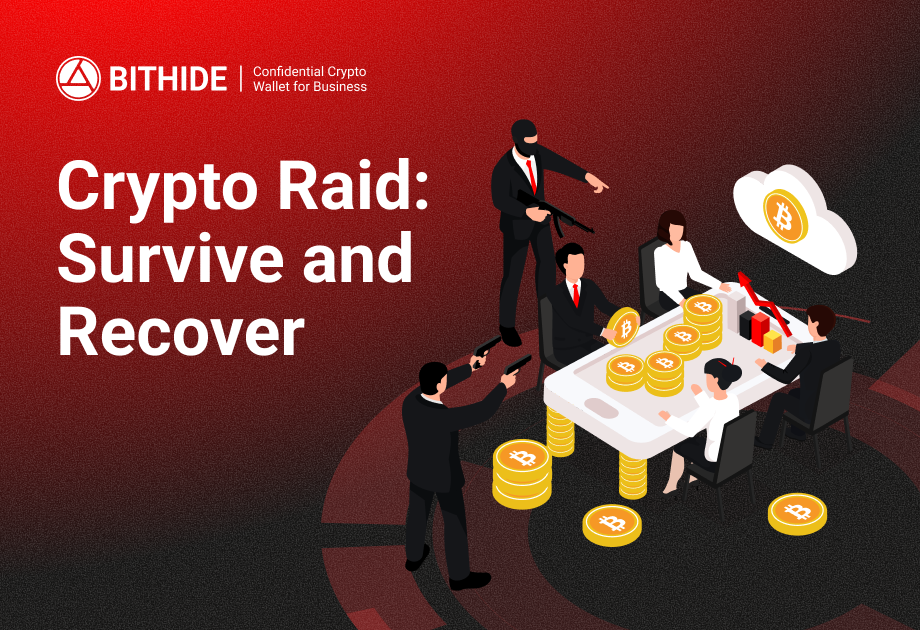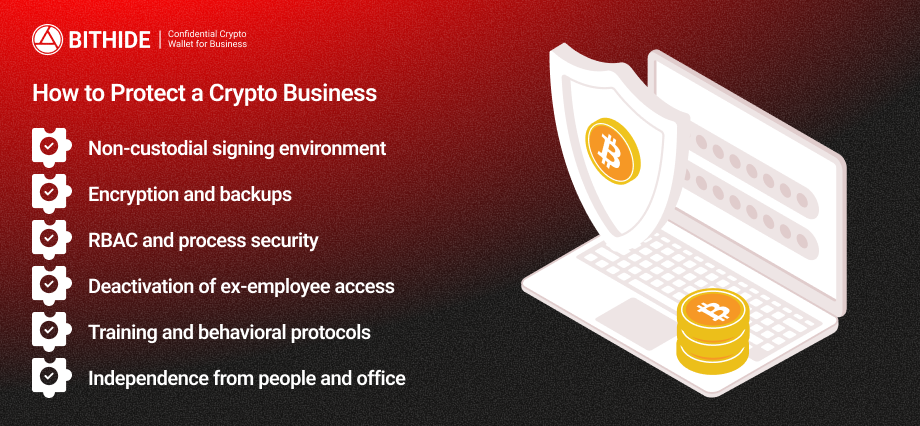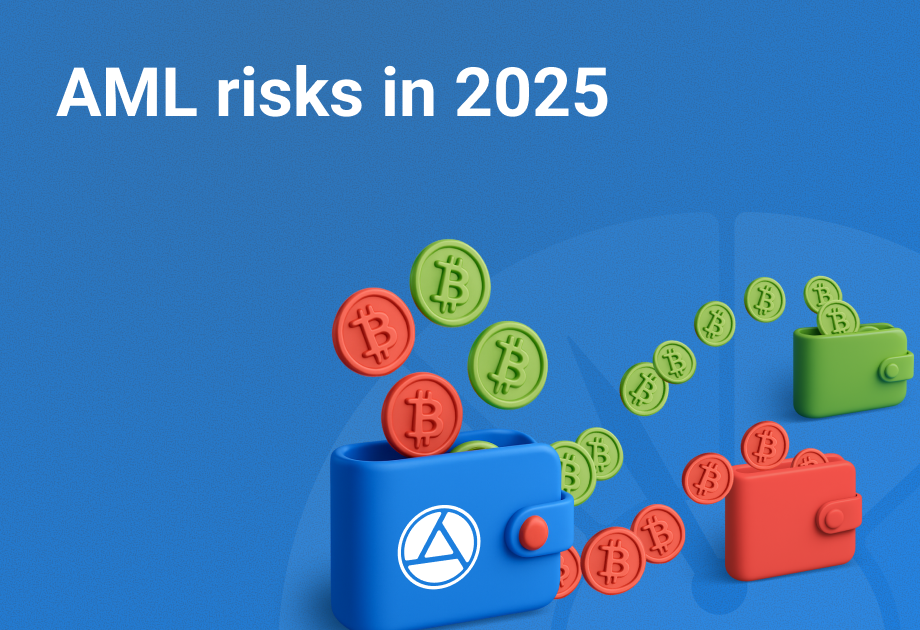Office Attack: How BitHide Saved Client’s Crypto Business
Survive crypto raids with non-custodial tech.

Note: Names, titles, and secondary details have been altered or intentionally omitted for security reasons. Technical actions are described in general terms and are not an instruction for bypassing security measures.
One of our clients faced a similar situation: armed attackers broke into his office, forced employees to open the safe, and took cash, cold wallets, and equipment worth about $300,000.
Despite the incident, the business managed to quickly restore operations and resume onchain activity, maintaining access to key addresses and assets. This was possible thanks to non-custodial architecture and well-established internal processes.
In this article, we break down how the client managed to retain control over assets, how attackers identify businesses through crypto transactions, and what companies can do to stay secure.
Key Takeaways
- Business deanonymization often starts with off-chain data leaks and behavioral transaction patterns.
- In this case, the breach stemmed from offboarding mistakes and unrevoked access credentials.
- Attackers located the client’s office, broke in, and stole equipment and assets worth about $300,000.
- The company fully restored operations within 24 hours thanks to BitHide’s non-custodial architecture. Private keys remained uncompromised.
- The main lesson: today, a company’s weakest point is rarely the tech — it’s people and operational discipline.
How Crypto Flows Are Tracked
Whenever a business becomes a physical target, it always starts with de-anonymization. Without understanding who stands behind the addresses and transactions, a real-world confrontation cannot occur.
Dozens of information channels are used for this — both onchain and offchain. In practice, it looks like this:
- Offchain environment: Physical office, employee devices, internal data carriers. Leaks often come from former or dissatisfied employees, contractors, or people with access to logistics and equipment.
- Onchain behavior: Repeating transaction patterns, predictable payout schedules, fee structures, fund routes to exchanges and partner wallets. All of this builds a recognizable profile that helps identify a business even without direct connections.
- Organizational layer: Access discipline, role distribution, staff reactions under pressure, login or data transfer mistakes. Any deviation from the security pattern can become a lead.
- Geography: Office locations, building characteristics, cash collection schedules, courier visits, local work specifics. Even simple geotags in photos or videos can expose a company’s location.
Even if the crypto infrastructure is perfectly built and protected by encryption and distributed keys, the human factor remains the most vulnerable point. One conversation, a random photo, or a former employee leaking coordinates — and the entire protection layer may be compromised.
How Onchain Addresses Are Linked to Business
To understand real risks, companies need to know what signals can reveal the owner of crypto infrastructure. We describe them here in general terms — without deep technical details (a detailed article on tracing is available in our blog), but with the logic in mind.
IP address, metadata, and geolocation
Any onchain activity leaves a digital trace: session data, timestamps, the device used for transactions. Correlation of activity with working hours or regions helps analysts infer a company’s geography and structure.
Onchain behavior clustering
Repeating fund routes, characteristic amounts, and typical corridors to exchanges or partner wallets form consistent patterns that can identify a business even without access to internal systems.
KYC overlaps
If at least one participant in a transaction chain uses a personal verified account on an exchange or financial service, their data can be matched to onchain addresses. This links anonymous wallets to real individuals.
OSINT and organizational footprints
Job postings, office photos, contractors, schedules, business cards — all of this is publicly available. Even a single overlap between resume details and onchain activity can link a company to a project or address.
Communications and leaks
Screenshots from work chats, correspondence from corporate emails, internal documents or presentations with payment details — any of this can end up in open sources and become part of an investigation or attack.
It’s important to emphasize: this is not a manual, but a risk map. Our goal is to show how many signals remain visible to outside observers.
In case of BitHide, the IP address changes even before reaching the node. Each transaction is unique, and they cannot be linked to one another. Clustering is also hindered by our proprietary technologies.
But here’s what happened in our client’s case — and how the attackers found his office.
Client Case Timeline and Key Cause of De-Anonymization
Attackers broke into the office and seized hardware devices and cash worth about $300,000. The team quickly evacuated the location — but within 24 hours, the company operations had been fully restored.
How They “Found” the Company: A Leak from a Former Employee
According to our data and the client’s materials, the critical factor was human error and a data leak. Here’s how it unfolded:
- Offboarding problems: A former operations employee (hereafter, “ex-employee”) was responsible for schedules, courier windows, and deal confirmations via a corporate aggregator mailbox. Before leaving, their access was formally revoked — but secondary access (email forwarding to a backup inbox and a private Telegram bot for notifications) was not disabled.
- Combination of small details: The ex-employee retained fragments of internal data — a draft of the cash delivery schedule, photos of the office entrance and hallway, email templates mentioning the legal entity and floor number, courier contacts. Separately, this seemed harmless, but together it formed a full context.
- “Monetization” of data: The ex-employee passed the information to attackers. They obtained data about the office location, times of peak operations, and visual cues — allowing them to pinpoint the target and plan the raid.
The cause of de-anonymization was not a technical flaw or IP address exposure — it was the human factor. The decisive elements were leftover accesses, poor deactivation of services after offboarding, and organizational details revealing the company’s operations and location.
How Assets Were Preserved: BitHide’s Role (Technical Side)
The key to resilience was BitHide’s non-custodial architecture and strict operational discipline. Below are the technical principles that allowed the business to stay afloat even after physical equipment was seized:
Non-custodial signing environment
- Private keys and signing logic are hosted on the client side, not by an external provider.
- Signing rights are not tied to specific hardware — meaning that device seizure does not equal loss of control over funds.
Encryption of key materials and deterministic recovery
- Seed phrases were encrypted and stored outside the office.
- Access restoration followed a pre-defined playbook: deploy a clean node → confirm roles → rotate critical data.
RBAC and the absence of a single point of compromise
- A strict role-based access control (RBAC) policy limits each employee’s privileges to what’s strictly necessary.
- Even with physical device access, without the combination of factors (seed phrase + MFA + fingerprint technology + role confirmation), signatures cannot be compromised.
Alerts and monitoring
- Continuous event logs and instant Telegram notifications about any configuration change attempts.
- Within the first hour after the incident, the team identified anomalies and followed the protocol: Quarantine → Replacement → Recovery.
Migration to a “clean” environment
- Regulated transfer to an alternative host/data center: configs, trusted devices list, and admin role setup order.
- As a result, on-chain operations were fully restored within 24 hours. The team did not have to improvise an “emergency” process on the spot.
Result: All crypto assets stored in the business wallet were recovered on a new device.
The raid did not affect BitHide or cold wallets — seed phrases were held only by the owner, preventing any external access.
As one of the incident participants aptly put it: «In 2025, vulnerability is no longer just about tech or geography. When the infrastructure is secure enough, the human factor becomes decisive.»
A Short Security Checklist for Businesses

Especially relevant for P2P, OTC, crypto exchanges, and crypto payment services.
Non-custodial Wallet
All keys and signing logic remain with you. No provider or platform has access to your funds.
Encryption and Backups
Seed phrases and wallet backups are encrypted and stored outside the office. The recovery procedure is tested and reliable — access can be restored on a new device within hours.
RBAC and Process Security
Minimal privileges, short token lifetimes, and two-step confirmation for sensitive operations prevent unauthorized activity even if one participant is compromised.
Access Deactivation
Strict offboarding after employee departure: complete removal of email forwards, bots, mailboxes, and integrations. Mistakes here often trigger leaks.
Training and Behavioral Protocols
Teams regularly rehearse “first hour” response scenarios: acting under pressure, step-by-step recovery, and communication with partners.
Independence from People and Offices
Business continuity must not depend on a single person, device, or location. BitHide’s architecture ensures that asset control and operations can be restored even after a physical incident.
Conclusion
The office raid incident became a real test of organizational maturity. In 2025, business resilience is defined not by “hardware in a safe,” but by an architecture where signing rights and recovery remain with the owner — regardless of physical location or staff.
BitHide‘s architecture is total security built into the system itself: technologies that mask IP addresses and prevent transaction clustering, data and backup encryption, role-based access control (RBAC), 2FA, and much more.
To keep your business running fast, efficiently, and securely, book a BitHide demo.


